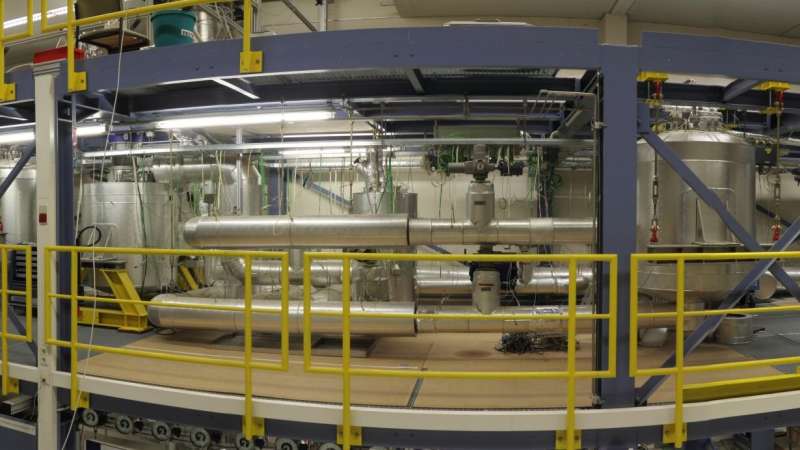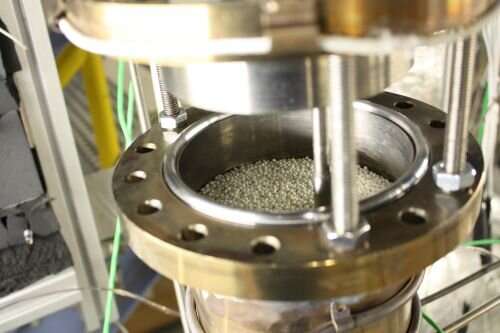
MAY 3, 2021 by Karlsruhe Institute of Technology
Collected at: https://techxplore.com/news/2021-05-renewable-energy-sources-large-scale-thermal.html?utm_source=nwletter&utm_medium=email&utm_campaign=daily-nwletter

High-temperature technologies enable electrothermal storage systems for large amounts of energy from renewable sources. Karlsruhe Institute of Technology (KIT), the German Aerospace Center (DLR), and the industry partner KSB have now launched the LIMELISA project to develop the necessary basis. Research is funded with EUR 3.8 million by the Federal Ministry for Economic Affairs and Energy.
Every year, wind parks and solar facilities in Germany produce thousands of gigawatt hours of power that cannot be used directly and therefore remain unused. At other times, lacking capacities are compensated by energy from fossil sources. Large-scale electrothermal storage systems may solve this problem and additionally enhance grid stability. The idea is to convert power into heat, to buffer this heat in comparably inexpensive storage systems, and to reconvert it into power, if necessary. “When using media, such as salt melts and liquid metals, for storage and heat transfer, very high temperatures can be reached,” says Professor Thomas Wetzel, who conducts research at KIT’s Institute for Thermal Energy Technology and Safety (ITES) and Institute of Thermal Process Engineering. “This opens up new applications for thermal storage systems in industry and creates ecologically and economically sustainable options for the climate-friendly transformation of energy supply.”
Thermal storage systems are already used on the industrial scale. Concentrating solarthermal facilities store heat in salt melts. Steam power plants convert the heat into power. Under the LIMELISA (stands for Liquid Metal and Liquid Salt Heat Storage System) project, scientists of KIT support the development of next-generation thermal storage systems, which are specifically designed for the power-heat-power process. Work concentrates on liquid metal technologies, whereas DLR focuses on salt melts. Research is coordinated and complemented by KSB, an internationally operating manufacturer of pumps and fittings that started to work with liquid-metal circuits in the 1960s.
Materials and Components for Highly Efficient Energy Storage Systems
Conventional electrothermal storage systems are operated on the basis of e.g. nitrate salt. Due to the materials and components (pumps, valves) used, however, they have only been operated at temperatures of up to 560°C so far. “For reconversion of heat into power by conventional steam power plants, much higher temperatures are required,” says project head Dr. Klarissa Niedermeier, ITES. “At KIT, we will test key components in a lead cycle of up to 700°C.” Due to direct contact with the liquid metal, special materials are required, which are also developed and tested at KIT. At the Institute for Pulsed Power and Microwave Technology, Dr. Alfons Weisenburger studies these special steel mixtures. “Conventional corrosion protection methods are no longer sufficient at such temperatures,” he explains. “Among others, we use aluminum oxide as a type of shield to protect pumps and fittings.”
Various Applications in Industry
Thermal storage systems can be applied in many areas, including sector coupling. Apart from the power-heat-power process studied by LIMELISA, the technologies developed can also be used to supply heat networks with renewable power. Such technologies can efficiently supply the high-temperature process heat required by chemical or construction industries or for metal processing. “Presently, this high-temperature heat demand is mainly met by fossil energy sources,” says Dr. Walter Tromm, Head of ITES. “High-temperature thermal storage systems would be an elegant option to use regenerative energy for key industrial processes and to solve the problem of volatile availability of regenerative energy sources.”

High-temperature technologies enable electrothermal storage systems for large amounts of energy from renewable sources. Karlsruhe Institute of Technology (KIT), the German Aerospace Center (DLR), and the industry partner KSB have now launched the LIMELISA project to develop the necessary basis. Research is funded with EUR 3.8 million by the Federal Ministry for Economic Affairs and Energy.
Every year, wind parks and solar facilities in Germany produce thousands of gigawatt hours of power that cannot be used directly and therefore remain unused. At other times, lacking capacities are compensated by energy from fossil sources. Large-scale electrothermal storage systems may solve this problem and additionally enhance grid stability. The idea is to convert power into heat, to buffer this heat in comparably inexpensive storage systems, and to reconvert it into power, if necessary. “When using media, such as salt melts and liquid metals, for storage and heat transfer, very high temperatures can be reached,” says Professor Thomas Wetzel, who conducts research at KIT’s Institute for Thermal Energy Technology and Safety (ITES) and Institute of Thermal Process Engineering. “This opens up new applications for thermal storage systems in industry and creates ecologically and economically sustainable options for the climate-friendly transformation of energy supply.”
Thermal storage systems are already used on the industrial scale. Concentrating solarthermal facilities store heat in salt melts. Steam power plants convert the heat into power. Under the LIMELISA (stands for Liquid Metal and Liquid Salt Heat Storage System) project, scientists of KIT support the development of next-generation thermal storage systems, which are specifically designed for the power-heat-power process. Work concentrates on liquid metal technologies, whereas DLR focuses on salt melts. Research is coordinated and complemented by KSB, an internationally operating manufacturer of pumps and fittings that started to work with liquid-metal circuits in the 1960s.
Materials and Components for Highly Efficient Energy Storage Systems
Conventional electrothermal storage systems are operated on the basis of e.g. nitrate salt. Due to the materials and components (pumps, valves) used, however, they have only been operated at temperatures of up to 560°C so far. “For reconversion of heat into power by conventional steam power plants, much higher temperatures are required,” says project head Dr. Klarissa Niedermeier, ITES. “At KIT, we will test key components in a lead cycle of up to 700°C.” Due to direct contact with the liquid metal, special materials are required, which are also developed and tested at KIT. At the Institute for Pulsed Power and Microwave Technology, Dr. Alfons Weisenburger studies these special steel mixtures. “Conventional corrosion protection methods are no longer sufficient at such temperatures,” he explains. “Among others, we use aluminum oxide as a type of shield to protect pumps and fittings.”
Various Applications in Industry
Thermal storage systems can be applied in many areas, including sector coupling. Apart from the power-heat-power process studied by LIMELISA, the technologies developed can also be used to supply heat networks with renewable power. Such technologies can efficiently supply the high-temperature process heat required by chemical or construction industries or for metal processing. “Presently, this high-temperature heat demand is mainly met by fossil energy sources,” says Dr. Walter Tromm, Head of ITES. “High-temperature thermal storage systems would be an elegant option to use regenerative energy for key industrial processes and to solve the problem of volatile availability of regenerative energy sources.”
Provided by Karlsruhe Institute of Technology
